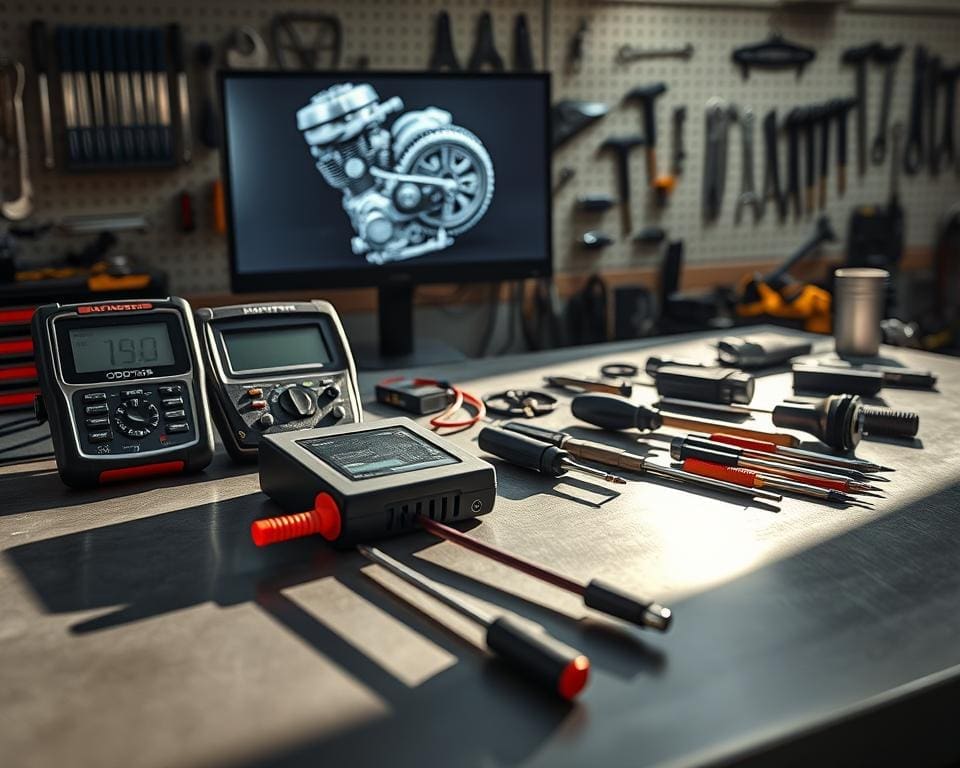In the bustling world of two-wheeled transport, ensuring your scooter or small engine vehicle’s optimal performance is essential. Regular scooter diagnostics and small engine vehicle checks are vital for maintaining vehicle health and preventing costly repairs down the line. Taking the time for routine maintenance allows you to diagnose issues early, ultimately safeguarding your investment and enhancing your riding experience.
Throughout this article, we will delve into the importance of diagnostics, identify key systems to monitor, and provide insights into effective tools and practices that can enhance maintenance routines. With an informed approach to vehicle health, you can enjoy your rides with confidence and peace of mind.
Understanding the Importance of Regular Diagnostics
Regular diagnostics play a pivotal role in maintaining the efficiency and longevity of scooters and small engine vehicles. Routine checks not only prevent unexpected breakdowns but also offer insights into the vehicle’s overall health. Emphasising the diagnostics importance, taking proactive measures through preventive maintenance can safeguard your investment.
The Benefits of Preventive Maintenance
Preventive maintenance serves as the backbone of a reliable riding experience. Key benefits include:
- Extending engine life by addressing minor issues before they escalate.
- Enhancing fuel efficiency through optimised performance.
- Ensuring rider safety by regularly checking critical systems.
By prioritising preventive maintenance, riders can drive with confidence, knowing they have mitigated potential risks.
How Diagnostics Can Save You Money
Investing in diagnostics can lead to substantial cost savings. Identifying problems early allows for minor repairs that are far less expensive than overcoming major failures. This proactive approach plays a vital role in:
- Minimising repair costs through early intervention.
- Reducing downtime, which translates into fewer disruptions.
- Enhancing overall vehicle reliability and performance.
Taking the time to understand the vehicle’s needs through regular diagnostics not only fosters peace of mind but also supports smart economic choices in the long run.

Key Systems to Diagnose in Scooters and Small Engine Vehicles
Regular diagnostics play a crucial role in maintaining the health of scooters and small engine vehicles. Understanding key systems can not only enhance performance but also ensure safety on the road. This section addresses the core areas that merit attention during diagnostics, focusing on engine health, electrics, and brake safety.
Engine Health and Performance
Conducting thorough engine diagnostics is vital for optimal performance. Key metrics, such as fuel mixture and oil quality, should be evaluated regularly. Inconsistent performance may indicate underlying issues that, if left unaddressed, could lead to significant repairs. Remaining proactive in these checks ensures the longevity and reliability of your vehicle.
Electrics and Battery Checks
An effective electrics check is essential for safeguarding your scooter’s functionality. Regular assessment of the battery’s charge, connection integrity, and starter performance can prevent unexpected failures. Sophisticated electrical systems, while remarkably efficient, require diligence to maintain. Neglecting these checks could result in inconvenient breakdowns and safety concerns.
Brakes and Safety Systems
Brake safety is non-negotiable when it comes to vehicle operation. It is crucial to inspect brake pads, fluid levels, and overall functionality to ensure responsive braking in all conditions. Routine evaluations contribute significantly to rider safety and overall vehicle integrity. Investing time in understanding and addressing brake systems can create a safer driving experience.
Essential diagnostics for scooters and small engine vehicles
Regular maintenance of scooters and small engine vehicles can significantly extend their lifespan. To achieve this, having the right diagnostic tools is essential. These tools empower owners to identify potential issues before they escalate. Below are some common diagnostic tools you should have and guidance on how to use them effectively.
Common Diagnostic Tools You Should Have
- Multimeters: Great for measuring voltage, current, and resistance, essential for electrical diagnostics.
- OBD-II Scanners: These devices are invaluable for reading error codes and monitoring engine performance.
- Brake Fluid Testers: Useful for checking the quality of brake fluid, ensuring safety and responsiveness.
- Tire Pressure Gauges: Helping to ensure proper tire pressure, critical for safe driving.
How to Use Diagnostic Tools Effectively
Using diagnostic tools correctly can enhance maintenance strategies. For instance, when utilising a multimeter, ensure proper contact with connectors to gather accurate readings. With OBD-II scanners, follow the prompts to read and clear error codes effectively. This diagnostics usage helps you to gather data that aids in making informed decisions regarding repairs and maintenance schedules. Regularly using these scooter maintenance tools not only saves you time and money but also ensures that your vehicle runs smoothly.
Identifying Common Issues through Diagnostics
Recognising issues in scooters and small engine vehicles is crucial for maintaining optimal performance and safety. Common symptoms can be indicative of more significant problems, such as engine issues, electrical problems, and the necessity for brake maintenance diagnostics. Understanding these signs empowers owners to take proactive measures.
Symptoms of Engine Troubles
Engine issues often manifest through distinct symptoms. Drivers may notice unusual noises, such as knocking or sputtering sounds that disrupt normal operation. Decreased acceleration or poor fuel efficiency are other tell-tale signs. Regular diagnostics can pinpoint the root causes, ranging from fuel delivery problems to underlying mechanical failures.
Electrical Issues and Their Solutions
Electrical problems are a frequent concern for scooter owners. Common indicators include dimming lights, erratic instrument panel readings, or failure to start. Suspected battery issues or damaged wiring may require attention. Employing diagnostic tools can help isolate the problem, allowing for targeted repairs that restore functionality.
Recognising Brake Wear and Maintenance Needs
Brake maintenance diagnostics are vital for safety on the road. Signs of brake wear, such as squeaking or grinding noises, should not be ignored. Regular inspections allow for timely replacements of brake pads and discs. A proactive approach ensures that riders maintain their safety and responsiveness when riding.
When to Seek Professional Diagnostic Services
Understanding the proper time to engage professional diagnostics ensures the longevity and reliability of your scooter or small engine vehicle. Ignoring critical signs can lead to more significant issues down the line. Knowing when to seek help can make a substantial difference in the performance and safety of your vehicle.
Signs You Can’t Ignore
There are numerous indicators that may suggest it is time to consult a professional. Pay attention to the following:
- Persistent performance issues, such as difficulty starting or loss of power during operation.
- Unusual smells that could indicate a problem with the engine or exhaust systems.
- Brake issues, including grinding noises or reduced responsiveness.
- Electrical problems, manifested as flickering lights or malfunctioning indicators.
Understanding Diagnostic Reports from Technicians
Once you’ve opted for professional diagnostics, technicians will often provide detailed diagnostic reports. These documents can appear complicated at first glance, but a clear understanding of them is crucial for effective vehicle maintenance. Look out for explanations around:
- Specific issues identified during the diagnostic process.
- Recommended repairs and parts that may need replacement.
- The urgency of addressing the identified issues, helping you to prioritise actions.
Engaging with these reports allows vehicle owners to communicate effectively with technicians, fostering better strategies for long-term care and maintenance.
DIY Diagnostics: What You Can Do at Home
Taking charge of your scooter’s maintenance can be rewarding. With the right knowledge and some essential scooter tools, you can perform DIY diagnostics that enhance your riding experience. This section outlines key tools needed for basic home maintenance, alongside a step-by-step guide for conducting essential checks.
Basic Tools for Scooter Owners
Every scooter owner should have a basic toolkit to perform DIY diagnostics effectively. Consider including the following tools in your collection:
- Screwdrivers (both flat and Phillips)
- Basic wrenches of varying sizes
- Tyre pressure gauge
- Oil measuring container
- Multimeter for electrical diagnostics
Step-by-Step Guide to Performing Basic Diagnostics
Executing basic diagnostics is straightforward with the right approach. Follow these steps for a reliable check-up:
- Check oil levels by removing the dipstick. Wipe it clean, reinsert, and check again.
- Inspect tyre condition visually for signs of wear and tear. Ensure proper inflation using a tyre pressure gauge.
- Test brake performance by squeezing the brake lever. It should feel firm without excessive travel.
- Use a multimeter to check battery voltage and ensure the electrical system functions correctly.
Engaging in these DIY diagnostics not only fosters self-reliance but also deepens your understanding of scooter upkeep. By integrating simple home maintenance practices, you can enjoy a smoothly running scooter and potentially avoid costly repairs.
Future Trends in Diagnostics for Scooters and Small Engines
The landscape of future diagnostics for scooters and small engines is evolving rapidly, showcasing the profound impact of technology in vehicle maintenance. As we embrace the digital age, advancements in diagnostics will not only enhance accuracy but also streamline the entire monitoring process, ensuring that users can maintain their vehicles effortlessly. The integration of smart technology means owners can access real-time data on their vehicle’s health, making it simpler to identify potential issues before they escalate.
Innovations such as AI-driven diagnostic tools and specialised mobile applications are at the forefront of this evolution. These tools are designed to provide insightful analyses, making diagnostics more user-friendly and accessible for everyone, regardless of technical expertise. As a result, owners can easily interpret data and receive recommendations tailored to their specific needs. The future diagnostics landscape will empower individuals to take charge of their maintenance schedules, fostering a proactive approach to vehicle care.
Ultimately, the promising advancements in diagnostics signal a new era for scooter and small engine maintenance. With improved technologies on the horizon, users will experience smarter, more efficient practices that enhance overall vehicle performance and longevity. As we look to the future, embracing these innovations will undoubtedly transform how we maintain our scooters and small engines, making vehicle health management more intuitive and enjoyable.









